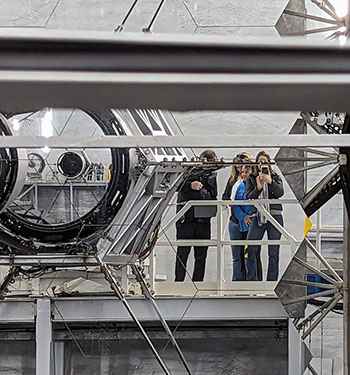
A delegation of dignitaries from the University of California Office of the President, UC Merced and UCLA were recently treated to a presentation that included the astrophysicists from UC Merced at the William M. Keck Observatory headquarters in Waimea, Hawaii.
Professors Anna Nierenberg and Sarah Loebman and Vice Chancellor for Research and Economic Development Gillian Wilson, who comprise the astrophysics faculty so far, addressed the group to explain their research and the importance of the Mauna Kea observatory not only for the three of them, but for undergraduate and graduate students and the future of astrophysics at UC Merced.
 The University of California is a part-owner of the Keck facility, and its researchers must apply and be approved for observation time based on the merit of their proposals. UC astronomers have access to its telescopes over 100 nights of the year.
The University of California is a part-owner of the Keck facility, and its researchers must apply and be approved for observation time based on the merit of their proposals. UC astronomers have access to its telescopes over 100 nights of the year.
Wilson, who studies galaxy evolution, clusters of galaxies and cosmology, has spent many nights looking through the high-powered and extremely high-resolution telescopes that sit at the top of the volcano, where the air is typically clear and unimpeded by light pollution.
“We had presentations from UC Observatories, which is the systemwide central hub for the nine astronomy-active campuses, we met with Professor Andrea Ghez, one of the UC’s two Nobel laureates in physics and look over the shoulders of her team while they were observing. We went to the 14,000-foot summit and had a tour of the facilities, including the twin 10-meter telescopes, which are the telescopes that Sarah, Anna and I use,” Wilson said. “We told the delegations about our experience and our students’ experiences using the Keck facilities, and about the UC Merced astrophysics program and all the great work that is being done.”
Loebman, who studies galaxy evolution, clustered star formation and chemo-dynamics in the local universe, is relatively new to observational astronomy. She typically uses high-resolution galaxy simulations, survey data and big-data tools and techniques to connect the present-day motion of stars to the Milky Way’s dynamic past.
“We talked a bit about how truly extraordinary these facilities are, especially Keck’s adaptive optics system that accommodates turbulence in the atmosphere and produces images that are, in some cases, better than the Hubble telescope,” she said. “This hadn't really resonated with me until I actually saw the telescopes, saw the images and heard Anna discuss it.”
The delegation, including UC Merced Chancellor Juan Sánchez Muñoz and interim Executive Vice Chancellor and Provost Marjorie Zatz, had the opportunity to look closely at the mechanisms that make these telescopes so accurate, and the images they produce so crisp.
The observations are not done at the summit, because it is dangerous to stay up there too long without supplemental oxygen. Instead, there is an observation station near the foot of the mountain, where researchers, students and even community members can see parts of the universe that would otherwise not be visible to humans. Keck’s public outreach events and other educational programs reach more than 50,000 people annually, according to the observatory.
But viewing can also be done remotely — even from Merced. The astrophysicists have already been able to demonstrate this to a large group of interested students, and plan to hold more viewing events, both in the lab and in the field for the campus community and the public.
Loebman has viewing time scheduled for Jan. 1, 2024, and she plans to take students with her to Hawaii.
Keck is one of the largest ground-based telescopes on Earth, and it is critical to the research conducted by people such as Nierenberg, who focuses on star formation and the nature of dark matter, which is believed to account for about 85 percent of the matter in the universe and about a quarter of its total mass–energy density. She studies dark matter halos, which envelop entire galaxies. Studying these halos could lead to new information about galactic formation and evolution and the nature of dark matter.
“Keck can do science at the level of the best space-based observatories, so our students will have amazing opportunities,” Nierenberg said. “Having access to this world-class facility is a unique thing for any campus, but especially a new campus like ours.”






